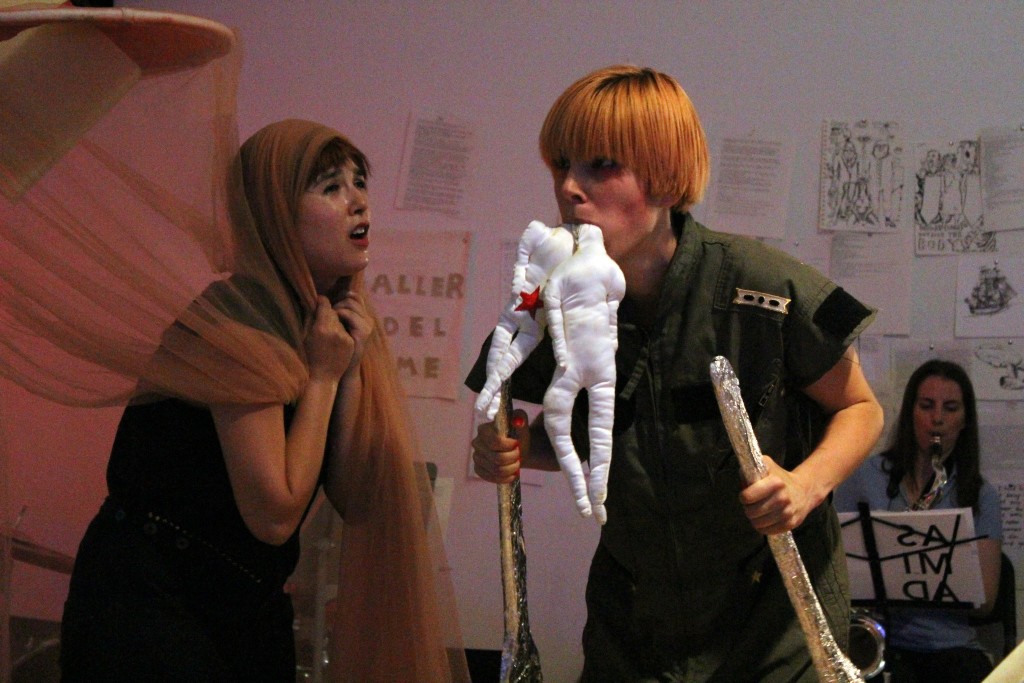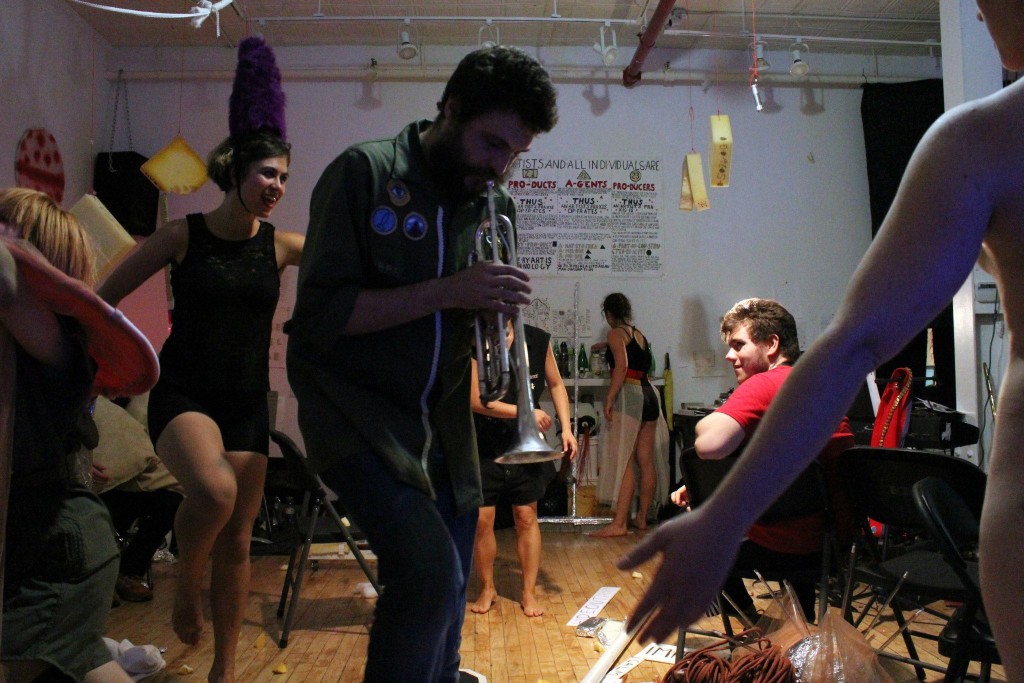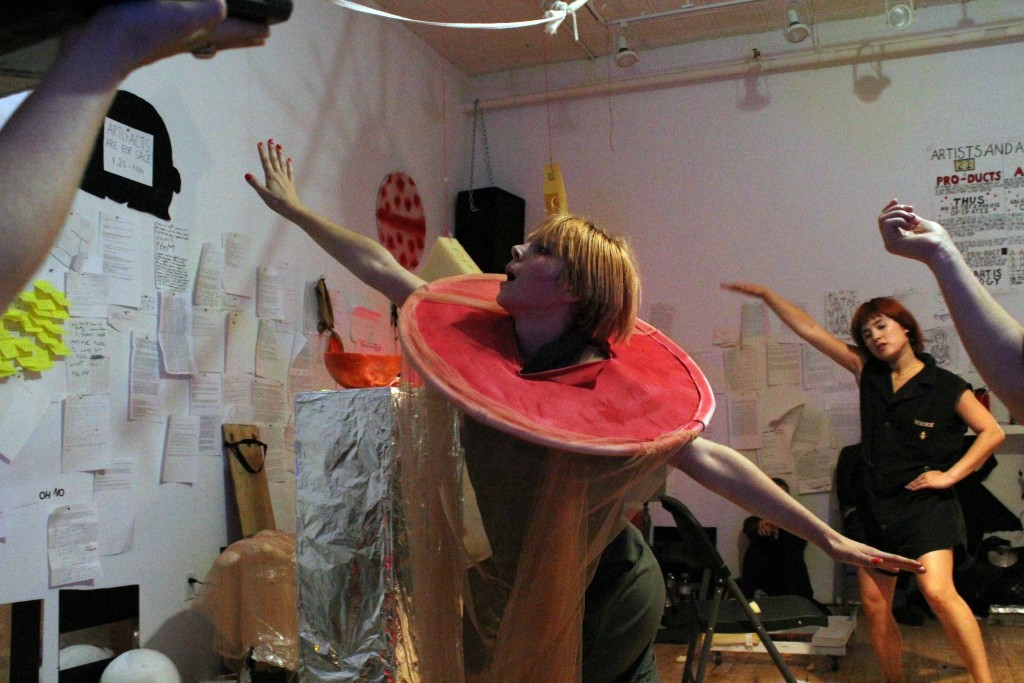Author | Li Cata
Featured photograph of René Kladzyk
Photography by Robert Zott
Is there a name for the kind of theater that aims to reach through the fourth wall, shake an audience member, and tell that person how to live? Not merely immersive theater because so many popular shows of dubious quality include an immersive shtick despite a lack of intellect or curiosity. Maybe more apt is that category of theater described in Peter Brook’s The Empty Space, the holy theater? Maybe Antonin Artaud’s theater of cruelty?
Any Size Mirror is A Dictator, the experimental opera led by Lindsey Drury and Panoply Performance Laboratory’s Esther Neff and Brian McCorkle, is all of these things: cruel, holy and immersive. But not the kind of immersive that demands players look you in the eye. Instead the opera’s cast lives out its ideas of existence in front of you, even with you. Rather than drawing you into a fiction, ASMIAD’s players fictionalize the real world in which the performance takes place. Can time repeat? When and where does a performance “end” or “break” and life begin? Take away the convenience of verbal communication and what remains of the functions of words; what forms of communication take their place? (The performers all had to “speak” by spelling out each word with their individualized body vocabularies.)

More than any other reference, even the Brechtian echoes outlined by Hyperallergic’s Jay Barnacle in his thoughtful though harsh review, ASMIAD strikes me most strongly as exemplary of Peter Brook’s ideas of effective theater in The Empty Space, in which Brook talks about theater in simplified terms, “deadly,” “holy,” “rough,” and “immediate.” These terms act both as entry-points for Brook’s rhapsodizing on an ideal theatrical vision as well as necessary elements (and one undesireable element: the “deadly”) for a total theater: a sincere intention of ceremony and discipline, a makeshift adaptability in the world, and a sense of confrontation.
ASMIAD resembles a combination of Brook’s holy and rough theater. It’s a performance that both seeks to transport the viewer to another time-space dimension and simultaneously makes use of the haphazard resources at its disposal to magically make a thing of import from things without it. At once, you will see a taped floor design, typewritten pages pinned to the wall, papier mache balls, a bowling ball, musical instruments created of flaccid balloons and bowls, and paper stuffed dolls alongside the spectacle’s holy elements—a giant canvas of richly painted fit female dancer bodies with bowling ball heads, striking hand-sewed costumes of aviator onesies with lace lining at the openings and heavy flowing velvet skirts of boldly contrasting gold and black, a tripartite manifesto of cultural creation hanging from the wall, and a smattering of skilled instrumentalists with their keyboard, electric guitar, and drum kit, not to mention McCorkle’s chillingly resonant voice.

The rich materiality of the production overlaps its breathtaking physical and mental exhaustion. The mere time scope of the venture is overwhelming: four days a week from 3pm to 9pm for seven weeks, the dancers bang their bodies on the ground, cling desperately to objects, grip and claw at each other, frantically try to keep their movement alphabet up to speed with their vocalized thoughts, define their roles in or against the group at each moment, follow or ignore or challenge the dominant activity, rip up the materials from the in the space, repair the damage done by other players, throw off their clothes, or run to cover up another’s naked body. The desperation, confusion, and loss of sense is the rough theater, by which I interpret Brook to mean the drama of the body’s sweaty effort through hours of physical exertion and dedicated concentration, in this case to the intricate choreographic scores.
Yet, for all this excitement, the thrill for me is on the walls, which are lined with an encyclopedia’s worth of typewritten reflections of the directors (or “dictators” as they are called), the performers, and some odd external characters. The conflicts between players weave a heavy presence among the wall reflections, highlighting controversies that occurred at moments I found the most enjoyable, from my more external perspective. In one, Drury lashes out at McCorkle’s leading the performative cast as would a choir teacher, goading them with cues and sonically overpowering the performance. In another, McCorkle laments being relegated to a supporting role as a musician and not a collaborator on equal footing with the dancers, even questioning the pigeonholing of the instrumentalists as “musicians” or a “band.” (The week after I read this writing, Butch Merigoni—part of this “band”—played a highly active role in the show maneuvering between his drums and the central space of the gallery while dancing, changing costumes, interacting physically with dancers, and playing his instrument.)

The dancers, too, reflect in multiple tacked pages wallpapering the sides of the gallery, often detailing what actions they took or observed others taking and why they made certain decisions. Occasionally, they, too, recognize these same confrontations—between the recursive cast and the performers or among the dictators or within an interaction between dancer and dictator.
These pages are not just windows for escape from long-winded, difficult, repetitive, “boring,” chaotic, or confusing moments (though they do serve this function as well), they provide avenues for audiences to further insert themselves into the gripping, curious, stimulating, and surprising experiences of the performance. The ability to recall stunning moments in these wallpapers allows spectators (as well as the members of the cast) to investigate their power and discover the internal and relational mechanisms that led to them.
Moreover the documentation of decisions, emotions, and tensions left as objects to aesthetically and psychically fill the space is an occasionally thrilling testament to the struggles of relating to art and other artists. Individual and collective. Cooperation and discordance. Objectification and hypersensitivity. Audience enjoyment and audience difficulty. Critiquing norms and creating a utopic alternative. Comfort and alienation. My experience of the run as well as these documents is framed by my first visit when, before the typewritings began spilling out in all directions, I saw pinned to the wall Michael Newton‘s “Acceptable Objectives for Art,” the bulk of which essay I cannot remember except the closing thought that, ultimately, the relation to art revolves around who you spend time with and what you spend time doing. The essay set me up to read all the following texts to refer to these questions and how I personally integrate creation, collaboration, expense of time, human relationship, and the mind-body. With such a heavy lens over the performance, every moment is weighted with self-reflection, every performer’s decision rife with symbolism, and every excitement (conflictual or joyful) an expression of my own libidinal relationship to art and culture. Maybe Barnacle is right, that the opera does not care about me, and thus offers itself to me as a mirror, through which I can see my own artistic struggles play themselves out—whether in the spectacle itself or within the typewritten representations of the players’ internalities. But I need that mirror.

PPL’s ASMIAD ends its seven-week run today, Sunday Oct 19th, with “open, evolving installation” from 3pm to 7pm and performances of the opera from 7pm to 9pm.
It takes place at Momenta Art in Bushwick at 56 Bogart St., Brooklyn, NY.
